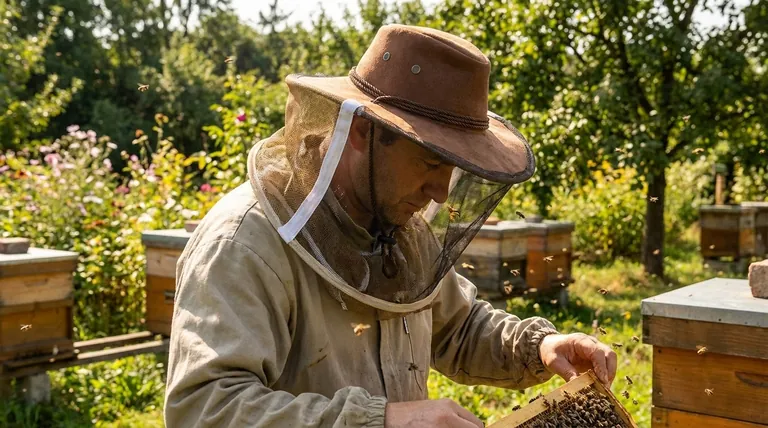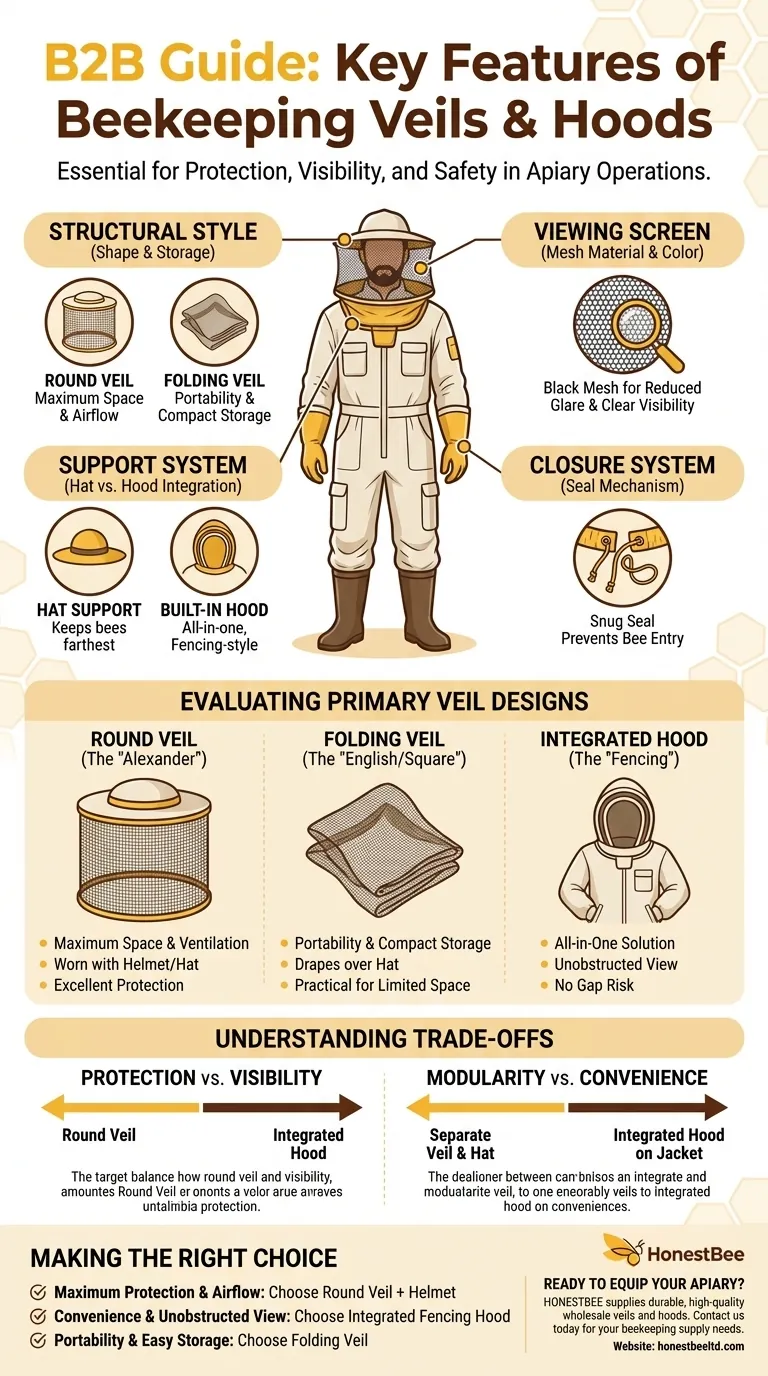At its core, a beekeeping veil is defined by four key features: its structural style, the material of the viewing screen, its integration with a hat or suit, and the closure system that secures it around your neck. These elements work together to provide essential protection for your face and neck from stings while allowing you to see and work effectively.
The most effective veil is not determined by a single feature, but by the one that provides a reliable, gap-free seal and clear visibility that you find comfortable enough to wear correctly every single time you approach a hive.

The Core Components of a Beekeeping Veil
Understanding the individual parts of a veil helps clarify how it provides protection and what to look for when evaluating quality.
The Structural Style
The shape of the veil determines the space around your head and how it's stored. The two most common standalone styles are the Round Veil and the Folding Veil.
The Viewing Screen
This is the mesh you look through. The screen's material and color are critical for both safety and usability. Most modern veils use a black screen, as it absorbs light and reduces glare, making it significantly easier to see through than lighter-colored mesh.
The Support System: Hat vs. Hood
A veil must be held away from your face. It achieves this either by being designed to fit over a separate hat or by having its structure built directly into a hood. A veil worn over a wide-brimmed hat generally offers the best protection by keeping bees the furthest from your skin.
The Closure System
This is the mechanism that seals the veil around your collar. It is one of the most critical safety features, as it prevents bees from crawling up into your veil. Look for a robust drawstring or elastic system that creates a snug, complete seal.
Evaluating the Three Primary Veil Designs
Each veil design prioritizes a different balance of protection, visibility, and convenience.
The Round Veil (The "Alexander")
This traditional design uses a rigid ring at the top and bottom to create a large, cylindrical space around your head. It is typically worn over a separate helmet or wide-brimmed hat.
Its primary advantage is maximum space, which keeps bees far from your face and provides excellent ventilation.
The Folding Veil (The "English" or "Square")
This design folds flat for easy storage. It drapes over a hat and is less rigid than a round veil.
Its main benefit is portability and compact storage, making it a practical choice for beekeepers with limited space.
The Integrated Hood (The "Fencing")
This modern style is built directly into a beekeeping jacket or full suit. It has a built-in structure that keeps the mesh away from your face, similar to a fencing mask.
This design offers an all-in-one solution with no risk of a gap forming between the veil and jacket. It also provides an excellent, unobstructed field of view.
Understanding the Trade-offs
Choosing a veil involves balancing competing priorities. There is no single "best" option, only the best option for your specific needs.
Protection vs. Visibility
A rigid round veil offers superior protection by keeping the mesh a significant distance from your skin. However, some find the support rings can slightly impede peripheral vision. A fencing-style hood sits closer to the face but often provides a wider, clearer field of view.
Modularity vs. Convenience
A separate veil and hat combination is modular. You can replace just one component if it's damaged. An integrated hood on a jacket is highly convenient, offering a quick, all-in-one solution with fewer potential points of failure (gaps).
Durability vs. Storage
The rigid structure of a round veil makes it very durable but also bulky and difficult to transport. A folding veil is exceptionally easy to store but may be more susceptible to wear and tear along its creases over time.
Making the Right Choice for Your Goal
Select your veil based on what you value most during hive inspections.
- If your primary focus is maximum protection and airflow: Choose a round veil paired with a separate, wide-brimmed helmet.
- If your primary focus is convenience and an unobstructed view: Choose an integrated fencing-style hood on a jacket or full suit.
- If your primary focus is portability and easy storage: Choose a folding (or "square") veil that can be packed flat.
Ultimately, the right veil is the one that gives you the confidence to work calmly and safely with your bees.
Summary Table:
| Feature | Key Consideration | Primary Benefit |
|---|---|---|
| Structural Style | Round, Folding, or Integrated Hood | Determines protection level & portability |
| Viewing Screen | Black mesh for reduced glare | Ensures clear visibility while working |
| Support System | Separate hat vs. built-in hood | Balances protection, space, and convenience |
| Closure System | Drawstring or elastic seal | Prevents bee entry for ultimate safety |
Ready to equip your apiary with the right protection?
HONESTBEE supplies durable, high-quality beekeeping veils and hoods designed for the demands of commercial apiaries and distributors. We understand that your safety and efficiency are paramount. Our wholesale-focused operations ensure you get the reliable equipment you need to protect your team and work confidently with your hives.
Contact HONESTBEE today to discuss your beekeeping supply needs and request a wholesale quote.
Visual Guide

Related Products
- Heavy Duty Cowboy Beekeeper Hat with Visibility Veil Outdoor Professional Beekeeping Protective Gear
- Beekeeper Cowboy Hat and Veil for Beekeeping
- Square Folding Bee Hat Veil with String for Beekeeping
- Cotton Beekeeping Suit and Round Hat with Veil Bee Keeper Protective Gear
- Professional Beekeeping Suit for Kids and Girls Childrens Bee Keeper Suit
People Also Ask
- What is the purpose of the high visibility veil on the beekeeping hat? Ensure Maximum Safety and Clarity
- What features enhance the quality of the beekeeping veil? Choose the Right Protection for Your Apiary
- What is the purpose of a hat and veil in beekeeping? Essential Protection for Head & Face
- What are the benefits of the lightweight fabric used in the beekeeping hat veil? Enhanced Visibility & Comfort for Hive Work
- How should the beekeeping hat veil be cleaned? The Only Safe Method to Preserve Protection



















